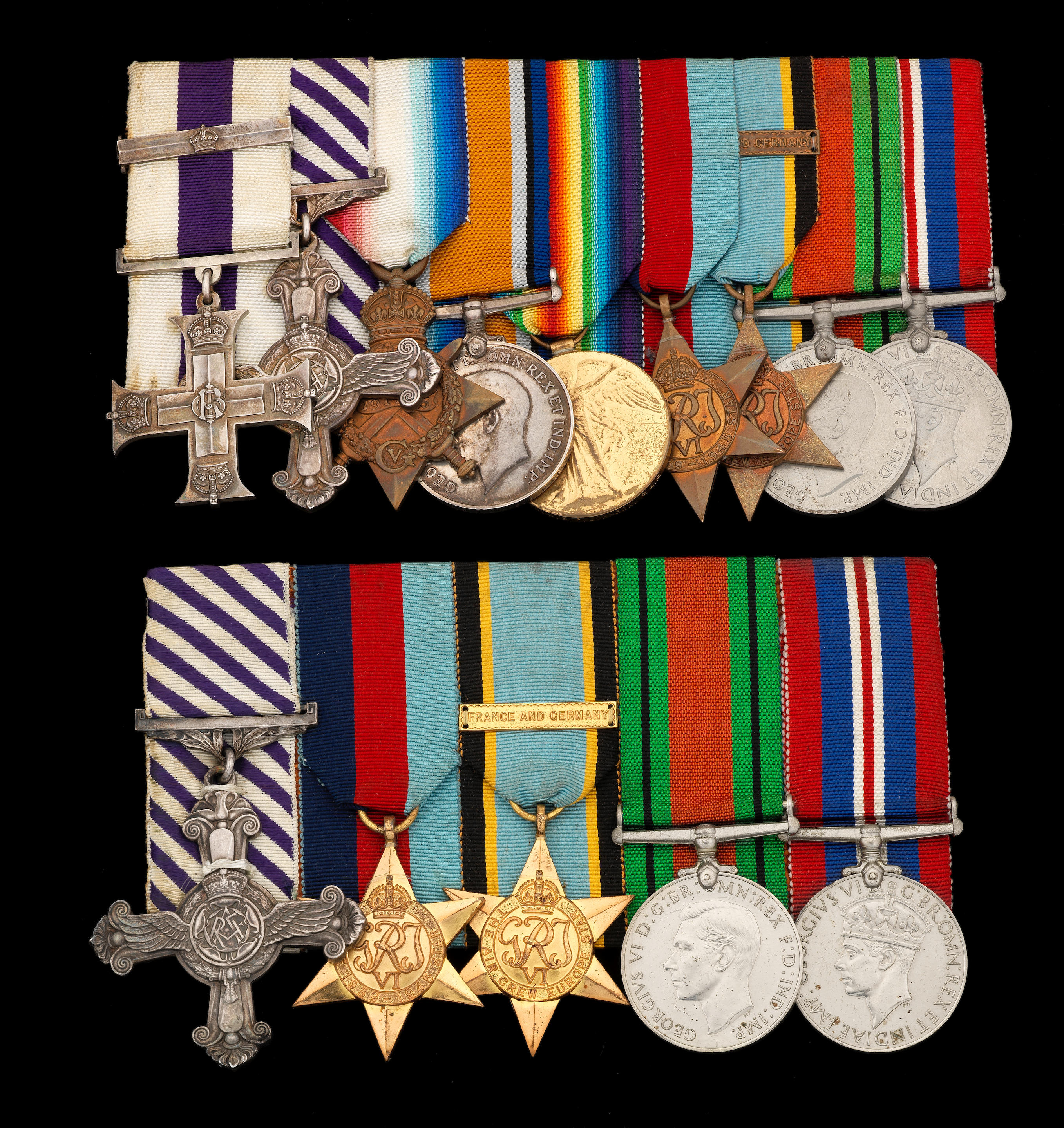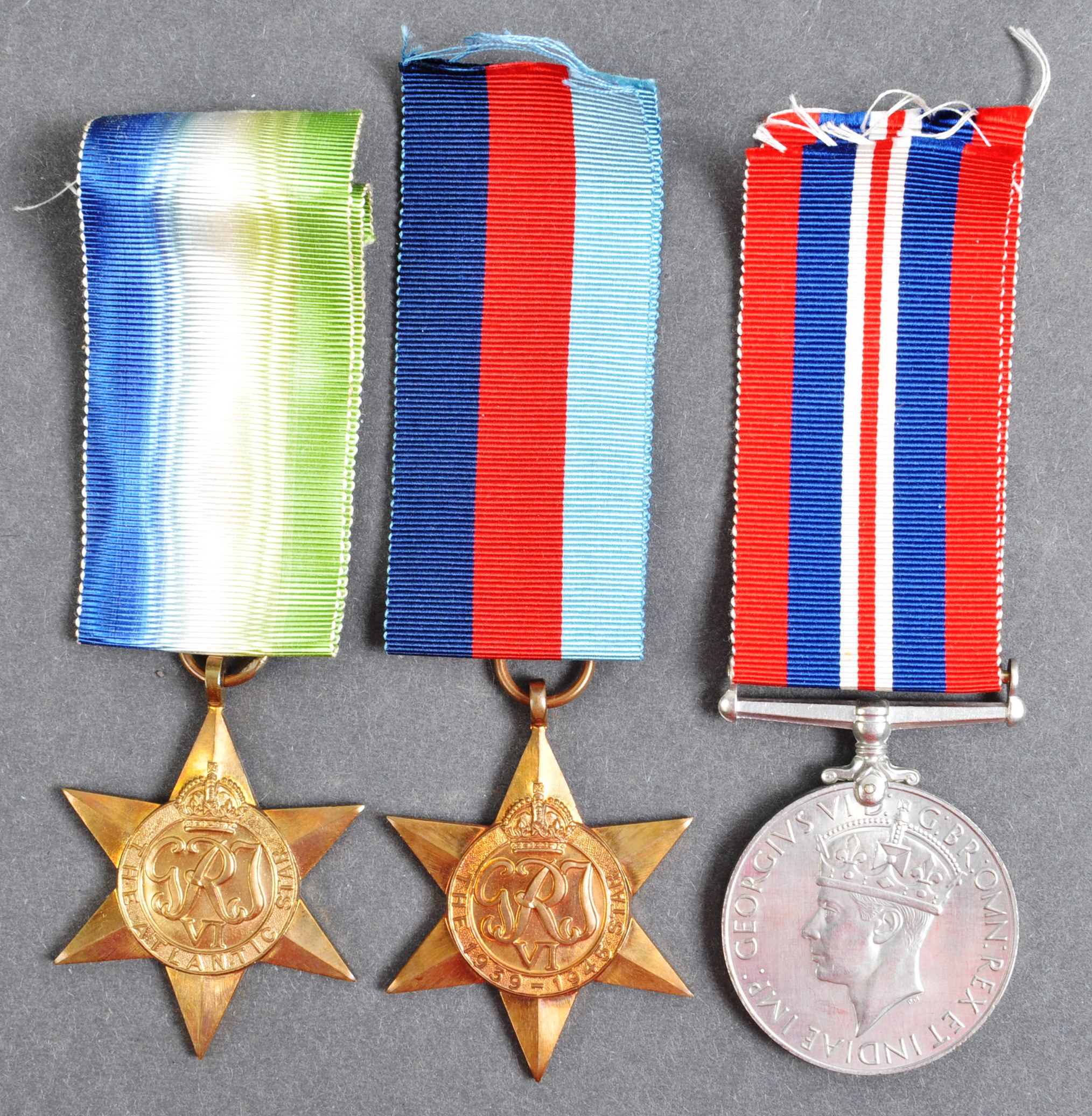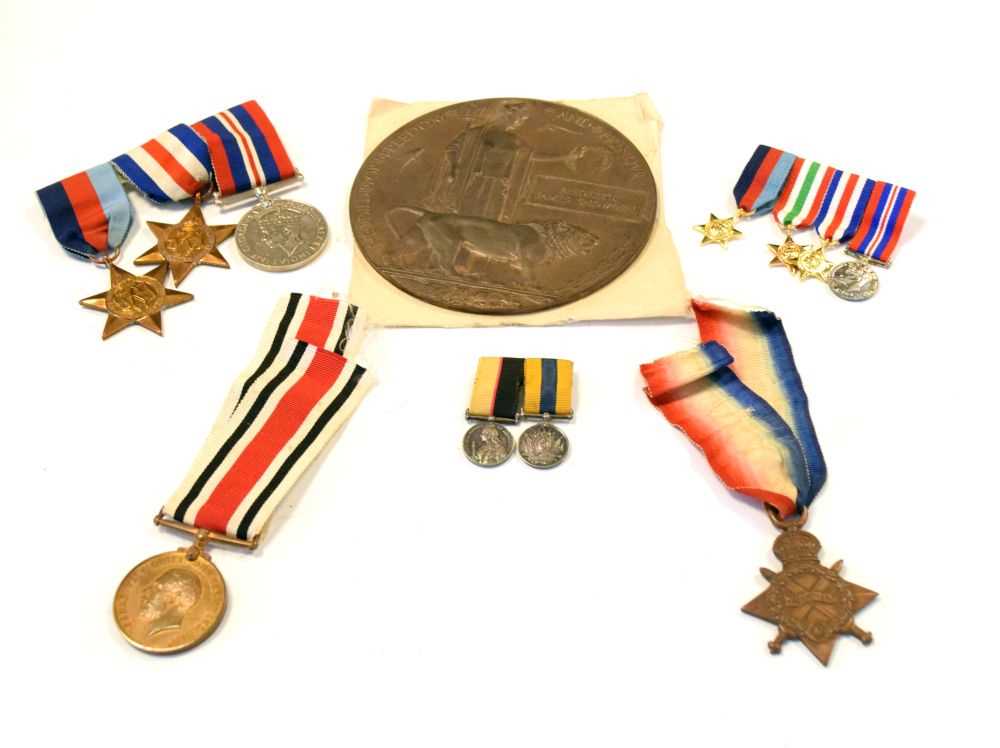A Second World War night fighter’s campaign group of five awarded to Warrant Officer A. G. V. “Gerry” Holton, Royal Air Force Volunteer Reserve, who flew operationally as an Air Gunner in Defiants of No. 141 Squadron during the Battle of Britain and as a Navigator (Radar) in Beaufighters of No. 89 Squadron in the Middle East 1942-43 - including a posting to Malta at the height of the siege 1939-45 Star, clasp, Battle of Britain; Air Crew Europe Star; Africa Star, clasp, North Africa 1942-43; Burma Star; War Medal 1939-45, generally good very fine (5) £3000-3500 Footnote Arthur Gerald Vaughan “Gerry” Holton enlisted in the Royal Air Force Volunteer Reserve in the summer of 1939 and was called up on 1 September, completing his training as an Air Gunner in June 1940. Posted to No. 5 O.T.U. at Aston Down, he converted to Defiants and joined No. 141 Squadron in mid-August. As verified by Richard Collier in Eagle Day, his future looked pretty bleak: ‘A two-seater fighter with an unwieldly power-operated gun-turret, the Defiant’s Dunkirk success had been the merest fluke: no Luftwaffe pilot had then met a “Hurricane” boasting a rear-gunner. But the surprise had been minimal. Within weeks the Germans knew the Defiant for what it was: a humped-backed non-starter, lacking all forward armament, with a maximum speed of 304 miles an hour. Since the pilots relied solely on their gunners’ verbal instructions to manoeuvre into a firing position, they were almost powerless against frontal attack.’ To such stark statistics it should be added that Air Gunners like Holton had another problem. If the Defiant’s electrical wiring was damaged, the power-operated turret jammed and the gunner could not bale out. Under such frightening restrictions, he flew his first mission, a convoy patrol, out of Dyce, on the 23rd of the month. Five more patrols were flown in quick succession, the majority with Pilot Officer J. G. Benson, afterwards a highly successful night fighter pilot with a D.S.O. and two D.F.Cs to his name. The Squadron moved to Turnhouse at the end of the month, Holton flying with Sergeant R. C. Hamer on his first night operation on 8 September - Hamer would later be recommended for a posthumous V.C. as a Beaufighter pilot. And on the Squadron moving to Church Fenton a few days later, he teamed up with Sergeant H. E. Green, the pair of them completing another four night sorties by the month’s end, an He. 111 being sighted during one of them. And another enemy aircraft was seen on the second of three night patrols flown in October, probably a Ju. 88, but it was eventually lost in cloud - see Derek Wood’s The Narrow Margin. No. 141 had, meanwhile, been operating out of Biggin Hill and Gatwick. In early October Holton had the misfortune to meet a Do. 17 as he was being flown to the Squadron’s new base at Gravesend in a Magister, although his Flying Log Book reveals no further information on what must have been a worrying encounter. A few nights later he was back on patrol with Green. And in December, prior to being rested, he flew a night patrol with Pilot Officer E. J. Stevens, in which they pursued an enemy aircraft, possibly the He. 111 credited to Stevens in Men of the Battle of Britain. Holton returned to the operational scene with No. 141 in March 1941, flying a patrol over the Beachy Head area on the 8th, and in early April he flew on his first mission to France, patrolling the Cap Gris Nez to Boulogne area. In the following month the Squadron was sent north to Ayr, and Holton did not fly again operationally until his next posting to No. 89 Squadron, ‘A wizard outfit’, operating in the Middle East in Beaufighters, at the end of the year. By now a qualified Navigator (Radar), Holton teamed up with Pilot Officer Gifkins, the occasional ‘flap’ necessitating a few sorties being flown in the period January to March 1942, one of them ending in a crash landing - ‘Wrote Kite Off.’ But it was really once the Squadron had widened its brief to includ
A Second World War night fighter’s campaign group of five awarded to Warrant Officer A. G. V. “Gerry” Holton, Royal Air Force Volunteer Reserve, who flew operationally as an Air Gunner in Defiants of No. 141 Squadron during the Battle of Britain and as a Navigator (Radar) in Beaufighters of No. 89 Squadron in the Middle East 1942-43 - including a posting to Malta at the height of the siege 1939-45 Star, clasp, Battle of Britain; Air Crew Europe Star; Africa Star, clasp, North Africa 1942-43; Burma Star; War Medal 1939-45, generally good very fine (5) £3000-3500 Footnote Arthur Gerald Vaughan “Gerry” Holton enlisted in the Royal Air Force Volunteer Reserve in the summer of 1939 and was called up on 1 September, completing his training as an Air Gunner in June 1940. Posted to No. 5 O.T.U. at Aston Down, he converted to Defiants and joined No. 141 Squadron in mid-August. As verified by Richard Collier in Eagle Day, his future looked pretty bleak: ‘A two-seater fighter with an unwieldly power-operated gun-turret, the Defiant’s Dunkirk success had been the merest fluke: no Luftwaffe pilot had then met a “Hurricane” boasting a rear-gunner. But the surprise had been minimal. Within weeks the Germans knew the Defiant for what it was: a humped-backed non-starter, lacking all forward armament, with a maximum speed of 304 miles an hour. Since the pilots relied solely on their gunners’ verbal instructions to manoeuvre into a firing position, they were almost powerless against frontal attack.’ To such stark statistics it should be added that Air Gunners like Holton had another problem. If the Defiant’s electrical wiring was damaged, the power-operated turret jammed and the gunner could not bale out. Under such frightening restrictions, he flew his first mission, a convoy patrol, out of Dyce, on the 23rd of the month. Five more patrols were flown in quick succession, the majority with Pilot Officer J. G. Benson, afterwards a highly successful night fighter pilot with a D.S.O. and two D.F.Cs to his name. The Squadron moved to Turnhouse at the end of the month, Holton flying with Sergeant R. C. Hamer on his first night operation on 8 September - Hamer would later be recommended for a posthumous V.C. as a Beaufighter pilot. And on the Squadron moving to Church Fenton a few days later, he teamed up with Sergeant H. E. Green, the pair of them completing another four night sorties by the month’s end, an He. 111 being sighted during one of them. And another enemy aircraft was seen on the second of three night patrols flown in October, probably a Ju. 88, but it was eventually lost in cloud - see Derek Wood’s The Narrow Margin. No. 141 had, meanwhile, been operating out of Biggin Hill and Gatwick. In early October Holton had the misfortune to meet a Do. 17 as he was being flown to the Squadron’s new base at Gravesend in a Magister, although his Flying Log Book reveals no further information on what must have been a worrying encounter. A few nights later he was back on patrol with Green. And in December, prior to being rested, he flew a night patrol with Pilot Officer E. J. Stevens, in which they pursued an enemy aircraft, possibly the He. 111 credited to Stevens in Men of the Battle of Britain. Holton returned to the operational scene with No. 141 in March 1941, flying a patrol over the Beachy Head area on the 8th, and in early April he flew on his first mission to France, patrolling the Cap Gris Nez to Boulogne area. In the following month the Squadron was sent north to Ayr, and Holton did not fly again operationally until his next posting to No. 89 Squadron, ‘A wizard outfit’, operating in the Middle East in Beaufighters, at the end of the year. By now a qualified Navigator (Radar), Holton teamed up with Pilot Officer Gifkins, the occasional ‘flap’ necessitating a few sorties being flown in the period January to March 1942, one of them ending in a crash landing - ‘Wrote Kite Off.’ But it was really once the Squadron had widened its brief to includ















Try LotSearch and its premium features for 7 days - without any costs!
Be notified automatically about new items in upcoming auctions.
Create an alert